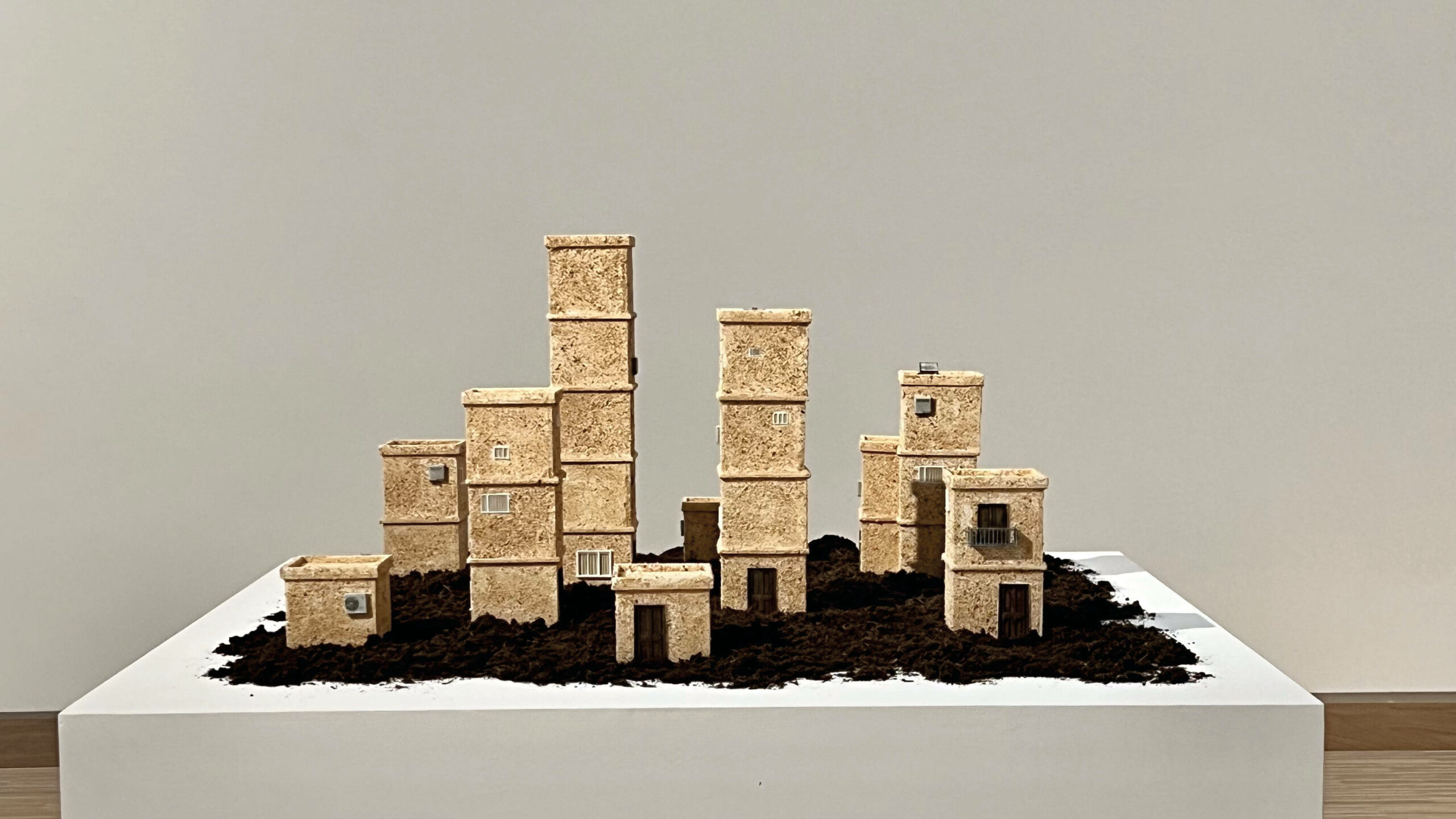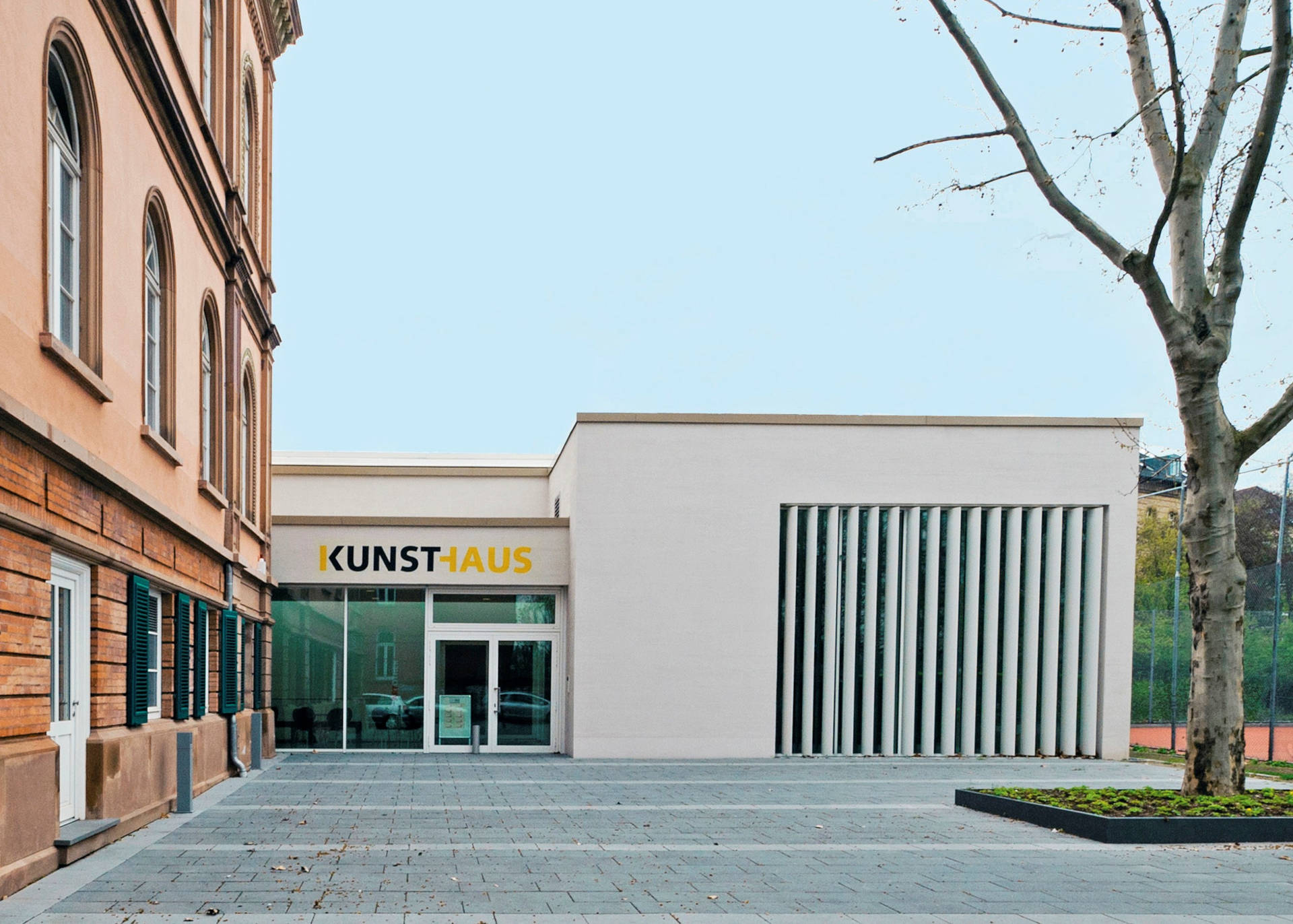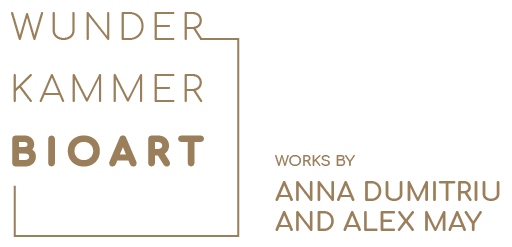For some years now, the fusion of art and the natural sciences has been experiencing a renaissance. Here lies the hope for new ways of perceiving the world, which not only contribute to the visualisation of complex concepts, but also offer potential solutions for global problems.
At the forefront here is BioArt – an artistic practice that works with living organisms and explores the nature of life. In this context, the process of artistic creation takes place in into laboratory spaces as much as the artist’s studio. Since the latter part of the 20th Century, artists intensively dealt with genetics, robotics, molecular and synthetic biology and have developed artistic projects in collaboration with scientists.
Among the most internationally renowned representatives of this movement are Anna Dumitriu and Alex May. The exhibition at Kunsthaus Wiesbaden shows three groups of works, each of which uses the gene scissors CRISPR/Cas – a molecular biological procedure that specifically alters DNA – in different challenging areas. The works were each created in the context of research projects that address solutions to global problems such as CO2 reduction, food security and antibiotic resistance.
hidden
continue reading
With the CRISPR/Cas method, the exhibition is dedicated to a highly topical subject – researchers Emmanuelle Charpentier and Jennifer Doudna were awarded the Nobel Prize in Chemistry for this in 2020. In their works, Dumitriu and May address fundamental questions raised by the use of genetic engineering: Where is the interface between “natural” and “artificial”? Where and when may humans intervene to modify organisms, and what values and limits underlie this?
Characteristic for the artistic strategy of Dumitriu and May is the linking of current scientific topics to historical developments. This artistic approach provides vivid access to research contexts that is otherwise rather difficult to access. In doing so, it draws attention to the role of non-human actors such as microorganisms or plants and the implications of an aesthetic engagement with them.
The exhibits are set within a broad context. Its significance for the works is inspired by the idea of the Cabinet of Curiosities (“Wunderkammer”). Already in the pre-modern era, these chambers united objects from nature, art, and science in order to call up previously unnoticed relationships to new associations. Then as now, the “Wunderkammer” can be understood as an idea for a place of exchange, networking, and intellectual bridge-building.
The exhibition is curated by Viola Hildebrand-Schat and Heike Sütter. Together with students of biology, art history, philosophy, and curatorial studies, they prepared the accompanying context, the supporting program, and digital mediation formats as part of an interdisciplinary seminar at Goethe University Frankfurt.
For the generous support we thank
Stadt Wiesbaden, Kulturfonds Frankfurt RheinMain, NASPA Kulturstiftung, Georg und Franziska Speyer’sche Hochschulstiftung, Goethe-Universität Frankfurt am Main Our thanks go further to the artists and their partners in the respective research projects. In particular, we would like to thank Prof. Dr. Diethard Mattanovich (Institute of Microbiology and Microbial Biotechnology, University of Natural Resources and Life Sciences, Vienna), Prof. Dr. Eckhard Boles (Institute forMolecular BioScience, Goethe University Frankfurt am Main), Sonja Schachinger, and the Frankfurt Association for Interdisciplinary Knowledge Transfer -Xplor e.V.

Photo: Anna Dumitriu and Alex May
Videos:
hidden
Fermenting Futures, Ars Electronica 2020, 9:04
hidden
Hefe - eine winzig große Geschichte, 2020, 6:30
hidden
Die Genschere im Laboreinsatz, 2022, 21:00
Fermenting Futures
Anna Dumitriu und Alex May, since 2020
Fermenting Futures explores the significance of yeast from cultural, scientific, ethical and aesthetic perspectives. Yeast’s ability to ferment alcohol and make bread rise has played a key role in the development of human civilisation from ancient times, but now we are asked to consider how yeast biotechnology might help us confront global environmental problems such as climate change and plastic pollution in the future.
The exhibited sculptures, installations, and textile works investigate the interrelationship of humans, yeasts and culture that has continued for millennia, but with a focus on new directions in synthetic biology.
Fermenting Futures was created in co-operation with Prof. Dr. Diethard Mattanovich, Prof. Dr. Michael Sauer, Dr. Özge Ata and Dr. Martin Altvater at the Institute of Microbiology and Microbial Biotechnology at the University of Natural Resources and Life Sciences, Vienna, as part of a strategic COMET project within the Austrian Center of Industrial Biotechnology (acib). Sonja Schachinger and Wolfgang Giegler are responsible for curatorial support.
Fermenting Futures is supported by the Austrian Federal Ministry for Digital and Economic Affairs (bmwd), the Austrian Federal Ministry for Transport, Innovation and Technology (bmvit), the Styrian Business Promotion Agency SFG, the Standortagentur Tirol, Government of Lower Austria and Vienna Business Agency through the COMET-Funding Program managed by the Austrian Research Promotion Agency FFG.
For the accompanying film material: Courtesy Institute of Microbiology and Microbial Biotechnology at the University of Natural Resources and Life Sciences, Vienna.
Make Do and Mend
Anna Dumitriu, 2017
Make Do and Mend references the 75th anniversary of the first use of penicillin in a human patient in 1941. Its key piece is an altered wartime women’s suit marked with the British Board of Trade’s utility logo CC41, which stands for ‘Controlled Commodity 1941’.
The holes in the suit have been patched with silk stained with pink colonies of E. coli bacteria, grown on dye-containing agar. The genomes of these bacteria have been edited, to remove an ampicillin antibiotic resistance gene and scarlessly patch the break with a fragment of DNA encoding the WWII slogan “Make Do and Mend”. Ampicillin is part of the penicillin group of antibiotics, so with this artistic genomic edit, the organisms were returned to their pre-antibiotic era state. Thus, the work encourages reflection on the global problem of antibiotic resistance and questions our approach to biotechnological advances.
Make Do and Mend has been created in collaboration with Dr. Sarah Goldberg and Dr. Roee Amit, The Synthetic Biology Laboratory for the Decipherment of Genetic Codes, Technion (Israel). With additional help and advice from Dr Heather Macklyne, University of Sussex (UK), Dr John Paul, Kevin Cole and Dr Nicola Fawcett, Modernising Medical Microbiology (UK).
Make Do and Mend has been created as part of the FEAT/Future Emerging Art and Technology project. FEAT is an initiative of eutema GmbH (AT), Stichting Waag Society (NL) and youris.com (BE). FEAT has been funded by the EU backed programme FET Open. It has received funding from the EU’s Horizon 2020 research and innovation programme.
For the accompanying material: Courtesy Annick Bureaud, Leonardo/Olats (podcast) and eutema GmbH (video)

Photo: Anna Dumitriu and Alex May
Podcast:
hidden
Bacteria as an Art Medium – Art Science. Conversation between Anna Dumitriu and Annick Bureaud, 2016, 21:01
Video:
hidden
Anna Dumitriu explains the MRG GRammar Approach to how Genes communicate among them, 2017, 1:31

Photo: Anna Dumitriu and Alex May
Videos:
hidden
Biotechnology from the Blue Flower: The Unnatural, that too is Natural, 1:29:32
hidden
H2020 CHIC Project. Explainer, 2020, 3:07
Biotechnology from the Blue Flower
Anna Dumitriu und Alex May, 2022
Biotechnology from the Blue Flower explores the cultural history and morphology of the chicory plant and investigates how new plant breeding methods can be used to create future healthcare and food benefits.
Chicory inspired the idea of the Blue Flower in German Romanticism, and became a central symbol of the movement. It inspired Goethe’s concept of the ‘Urpflanze’ and his “Metamorphosis of Plants”. The romantic movement was a reaction to the industrial revolution and held nature and emotion in the highest esteem. Now, we are part of a biotechnological revolution, and again the blue flower becomes an important symbol, but this time in a more complex position at the interface of nature and technology, questioning what may be acceptable in synthetic biology, and how ‘nature’ and ‘natural’ may be defined in the future.
Biotechnology from the Blue Flower has been created as part of the ASN-AIR programme 2018-2020 in the CHIC science labs. The residency commission was awarded through Art Science Node. ASN/ASSF is a partner in the CHIC Consortium. CHIC is a research and innovation project supported through the EU Horizon 2020 funding programme.
For the accompanying film material: Courtesy CHIC Consortium.
Virtuelle Tour durch die Ausstellung
Make a virtual tour through the exhibition using the 3D 360 degree platform Kuula.
Either open the Wunderkammer-BioArt tour on the kuula platform or start it here by clicking on the button below.
Art on your mobile phone
With the app ‘Actionbound’ you may interactively explore the exhibition and its backgrounds in a digital tour.
To play the bound, you have to download the free app ‘Actionbound’. The current version is available on the following website:
https://de.actionbound.com/download/
To start the bound, please scan the QR-Code using the ‘Actionbound’ app.
Bound-Page:
https://actionbound.com/bound/WunderkammerBioArtKunsthausWiesbadenAnnaDumitriuAlexMay

ACCOMPANYING EVENTS
Wed, 6 April 2022, 6:00 pm
OPENING
Welcome Address (in German)
Helga Tomaschky-Fritz
Citycouncillor of Wiesbaden
Karin Wolff
Managing Director Kulturfonds Frankfurt RheinMain
Talk (in German and English)
Anna Dumitriu and Alex May,
Artists
Thu, 7 April 2022, 11:00 am
Talk & Tour (in English)
Coffee morning with Anna Dumitriu and Alex May
Sat, 9 April 2022, 7:00 – 12:00 am
20th Short Night of Galleries and Museums (in German and English)
19.00 – 20.00 The curators Prof. Dr. Viola Hildebrand-Schat and Heike Sütter are present.
Foodtruck Tillys Tante
Thu, 28 April 2022, 6:00 pm
Gentechnologie – Heilsbringer oder Teufelszeug? (in German)
Conversation with Dr. Martin Fedler-Raupp, dean Protestant Church Kronberg, and PD Dr. habil. Alexander Nawar, ecumenical officer Diocese Mainz
In the course of the Week of Silence
Tue, 3 May 2022, 7:00 pm
Philosophischer Salon No. 14 zu Gast im Kunsthaus
Epigenetik – Revolution der Evolution? (in German)
Leon Joskowitz, philosopher, ethics teacher and gardener, talks with Bernhard Kegel, biologist and author, about epigenetics
In cooperation with the Cultural Department of the Jewish Community in Frankfurt
Wed, 11 May 2022, 6:00 pm
Art, Design & Science – Forschen, Studieren und Lehren zwischen den Disziplinen (in German)
Talk with Julia Ihls, managing director Bio Design Lab, HfG Karlsruhe, Valentin Brück, research assistant
Institute for Materialdesign (IMD) HfG Offenbach, and Studierenden der Goethe-Universität Frankfurt a. M.
Fri, 13 May 2022 and Fri, 10 June 2022, 1:30 pm
Lunchtime Art (in German)
Lunch impulse talk with Katarina Haage, student of art history, Goethe University Frankfurt a. M.
Sun, 15 May 2022, 11:00 am – 6.00 pm
International Museums Day “The Power of Museums”
14.00 Guided tour with the curators Prof. Dr. Viola Hildebrand-Schat and Heike Sütter (in German and English)
16.00 Kunst und Wissenschaft – eine Liebesbeziehung? Guided tour with Sophie Merz (student of biology)
and Fabian Korner, (student of philosophy), Goethe University Frankfurt a. M. (in German)

Thu, 19 May 2022 and Thu, 2 June 2022, 6:00 pm
After Work Stop (in German)
After work impulse talk with Katarina Haage, student of art history, Goethe University Frankfurt a. M.
Thu, 19 May 2022 and Thu, 2 June 2022, 6:00 pm
Mikroben! Museen! Versöhnung! (in German)
Guided tour with Tizian Holzbach, student of curatorial studies Goethe University and Städelschule, Frankfurt a.M., and Esther Gardei, research assistant and PhD student studies in reconciliation, Rheinische Friedrich-Wilhelms-Universität Bonn
Tue, 14 June 2022, 6:00 pm
Blaue Blume, Urpflanze, Waldeinsamkeit: Alte und neue Perspektiven aus der Wissenschaft (in German)
Salon conversation with JProf. Dr. Frederike Middelhoff, Modern German Literature / Romantic Studies,
Goethe University Frankfurt a. M. and Prof. Dr. em. Joachim W. Kadereit, Institute of Organismic and Molecular Evolution, Johannes Gutenberg University Mainz
Glossary from A to Z
Below, we explain the central terms related to the exhibition.

Kunsthaus Wiesbaden – Fotograf Patrick Baeuml
Kunsthaus Wiesbaden
Schulberg 10, 65183 Wiesbaden
Tel. 0611/319002, 0611/58027829 (Kunsthalle)
bildende.kunst@wiesbaden.de
www.wiesbaden.de/kunsthaus
Opening Hours
Tue – So 11:00 am – 5:00 pm, Thu 11:00 am – 7:00 pm
Registration
Please register for all events by email by the previous day, 12:00 pm: bildende.kunst@wiesbaden.de
Admission free
Admission to the exhibition and all events is free.
The current hygiene and distance rules of the state of Hesse apply.
